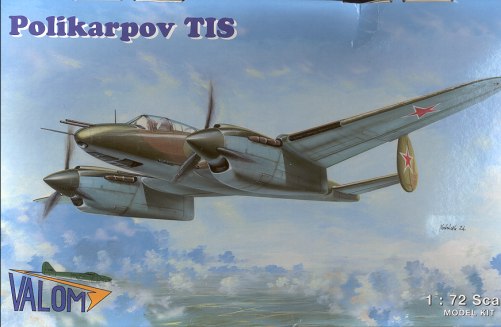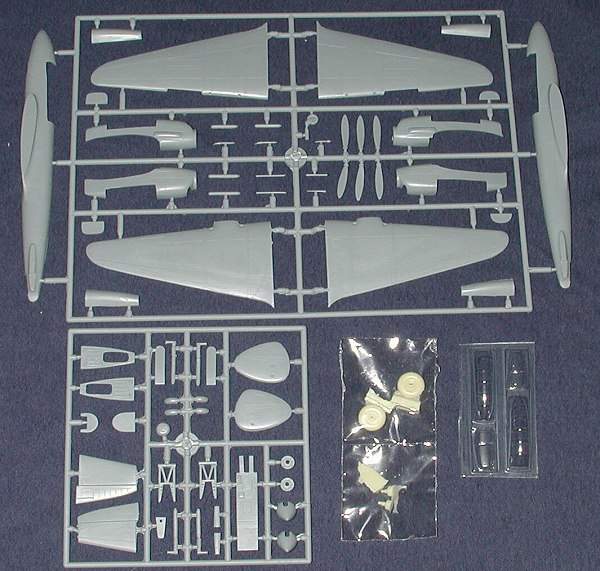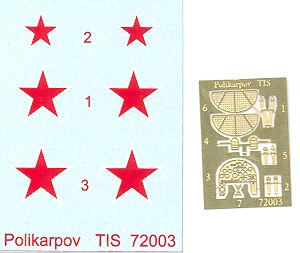
|
KIT: |
Valom 1/72 Polikarpov TIS |
|
KIT # |
72003 |
|
PRICE: |
$35.98 MSRP |
|
DECALS: |
Insignia |
|
REVIEWER: |
|
|
NOTES: |
Short run with vac canopy, etched fret & resin |

|
HISTORY |
In 1938, the Polikarpov Design Office was given the task of designing a plane capable of escorting the medium bombers throughout their flying range. This aircraft was called the TIS (Heavy Escorting Fighter). A first prototype called TIS(A), flew in September 1941. It was an all-metal construction of elegant design, driven by two liquid-cooled Mikulin AM-37 in-line engines of 1400hp each. It carried two crew members and was armed with four Shkas 7.2mm guns in the nose, two Shvak 20mm cannon in the wing roots and a single Shkas 7.2mm gun manned by the rear gunner.
Initial tests revealed problems with longitudinal stability and the AM-37s were never successful engines, having caused havoc with many budding aircraft designs. The worsening war situation caused all testing to be halted while the Polikarpov group was evacuated farther east. Tests continued in late October 1941, though were halted in March of 1942 by the need to work on other tasks. (It should also be pointed out that Polikarpov's star was falling rather fast, so his priority level was rather low).
The stability problem was solved and testing restarted in 1943. However, a new version, the TIS(MA) was developed using Mikulin AM-39 engines of 1700 hp in place of the troublesome AM-37s. The four nose Shkas machine guns were replaced with Shvak 20mm cannon in the nose and the wing root 20mm cannon replaced by those of 37mm. 15 more test flights were made from June to September 1944. However, after the death of Polkarpov and several accidents with the aircraft, the design group was broken up and the prototype left to its fate.
|
THE KIT |

This is the third kit from VALOM and it seems as if each one gets better. In my mind, the way to tell how much a company is improving is by how much less it relies on etched metal and resin to complete the kit. Now I know that sounds odd, but the fact is that most of us would much rather use 'standard' construction methods with a kit than have to rely on etched and resin bits for normal parts. If the maker wants to add in a few for additional detail, then fine, but a kit should be able to stand on its own with just injected pieces. All the major manufacturers do so. Having said that, I fully realize that when one is dealing with short run subjects, resin, etched metal, and vac bits are the norm and often the only way to produce some of these parts. For me, however, the fewer, the better! I should also mention that this kit is in a resealable bag. I really like this way of sealing in kits much better than a heat sealed one.
So let's talk about those bits with this kit. The etched brass fret is limited to the instrument panel, rudder pedals, engine intake grilles and the crew shoulder harness. That is perfect and quite reasonable. The brass bits are very well done. The canopy and nose transparencies are vacuformed plastic. They are well formed and two sets are provided for those of us who are known fumble-fingers. Resin is limited to main wheels, pilot's seat and prop hubs. The resin is well formed with some easily removed flash. My wheels had some pin holes on the hub.
The rest of the kit is molded in a medium grey plastic with nicely done engraved panel lines. They are not so fine as to disappear under the swipe of some sandpaper, but not so large as to be overwhelming. There are a few ejector towers on some of the larger pieces, but they are easily removed if need be. There is no flash and no sink areas. This is great as the horizontal stabs and vertical stabs are one piece and these bits are normally quite prone to sink marks.
 There is good
detail on the inside walls of the cockpit and the cockpit itself is nicely
outfitted with a combination of plastic, resin and etched metal bits.
I'm not real fond of separate prop blades, but perhaps this one will be
better as there are actual alignment pins in the hub for the blades. It
must be difficult to make one-piece prop blade assemblies, though I know
I'd personally much prefer them. As expected from a prototype, there are no
options and no external stores.
There is good
detail on the inside walls of the cockpit and the cockpit itself is nicely
outfitted with a combination of plastic, resin and etched metal bits.
I'm not real fond of separate prop blades, but perhaps this one will be
better as there are actual alignment pins in the hub for the blades. It
must be difficult to make one-piece prop blade assemblies, though I know
I'd personally much prefer them. As expected from a prototype, there are no
options and no external stores.
Instructions are very good, though a tad 'busy'. Color information is provided in Humbrol, Agama, Model Master and Federal Standard references. There are many smaller alignment diagrams provided to ensure that you don't get things off kilter when building, which is very much appreciated. Decals are basic insignia and the aircraft itself is in a disruptive pattern of Russian Green and Dark Earth over Russian Blue. Decals are quite thin and should work well.
|
CONCLUSIONS |
This is a really neat looking aircraft. It reminds me
somewhat of a Pe-2, though it is a bit smaller. Valom's kits are
continually improving and this one is no exception. If you like interesting
aircraft and prototypes, then this is one you really should consider
obtaining. Review kit from the fine folks at
Valom. Thank you for your
support. If you would like your product reviewed fairly and quickly by a
site that has well over 150,000 visitors a month, please contact
me or see other details in the Note to
Contributors.